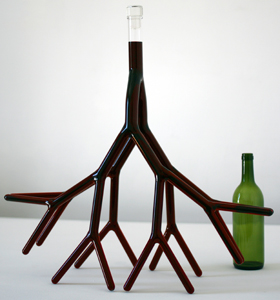Scheduled at the Fromm Institute during its winter 2011 session is a preparatory course on the San Francisco Opera’s upcoming Ring Cycle—consider paying the tuition for the opera-loving senior in the family.

Along with other aspects of wine’s visual and material culture, glassware has undergone a dramatic transformation. Decanters, such as this one that can be view at the current exhibit, and carafes have been reinvented to increase their oxygenating effects and to intensify their expressive character.
By Paul Duclos
Published: December, 2010
Scheduled at the Fromm Institute during its winter 2011 session is a preparatory course on the San Francisco Opera’s upcoming Ring Cycle—consider paying the tuition for the opera-loving senior in the family. This course consists of eight, 90-minute Tuesday lectures, January 11, 18, 25; February 1, 8, 15, 22 and March 1. Membership in the Fromm Institute is available for $225 and entitles students to attend any 4 of the 24 courses offered each session.
Here’s the course description: Wagner’s four-opera saga The Ring of the Nibelung is one of opera’s great treats with its epic power and music of transcendent beauty. In addition to listening to these awesome musical dramas, we will discuss the many myths Wagner used, his distinctive poetry, his system of musical motifs, his political and social evolution, his anti-Semitism, and the various stagings of his astonishing Ring. Join Fromm Institute Professor James Keolker for this exceptional opera experience—a fine preparation for the San Francisco Opera’s forthcoming Ring productions.
This course is presented at the Fromm Institute under the auspices of the Victor Marcus Chair in Opera Studies. For more information on how to register, please contact the Fromm Institute at (415) 422-6805 or email Fromm@usfca.edu. A full catalog of all winter 2011 courses (descriptions and faculty bios) is available upon request. For information on the Fromm Institute, visit www.usfca.edu/fromm.
Next, I’d like to highlight a novel worth gifting: The Second Life of John Wilkes Booth by Barnaby Conrad.
In 1865, at Ford’s Theater in Washington, John Wilkes Booth shot Abraham Lincoln with a derringer and plunged an entire nation into mourning. Escaping with a broken leg, Booth went into hiding. Weeks later, Federal troops surrounded a burning barn in Virginia and killed a limping man who resembled Booth. The body was quickly buried in a deep grave and most considered the case closed. But was it really Booth? Within months newspapers began reporting that he had been sighted in different parts of the country. In this gripping historical thriller, veteran novelist Barnaby Conrad imagines what would have happened if America’s most notorious assassin escaped to have a second life.
Barnaby Conrad was told this story over breakfast in 1947 by Sinclair Lewis, the first American author to win the Nobel Prize. Conrad, then just 25 years old, was working as the Laureate’s personal secretary, and listened in awe as the tale flowed. Lewis and the young author agreed to write the book together and actually typed up a contract to split the book profits 50-50. That contract is reproduced in the back of the novel as an artifact, but it took Conrad a lifetime to get around to writing the book.
Finally, the San Francisco Museum of Modern Art (SFMOMA) MuseumStore is offering unique and exclusive wine products in conjunction with the exhibition How Wine Became Modern: Design + Wine 1976 to Now, on view at SFMOMA from November 20 to April 17. From special glassware, carafes, and wine accessories to limited-edition prints, the MuseumStore has treasures for the wine lover in the family.
The exhibition features unique glassware that will also be on sale at the MuseumStore. Offered as a set of two, the Rotario-glass in motion ($135) is a stylish mouth-blown crystal stemless glass that rotates on its base. No matter how you put it down, it never tips over. Oxygen is automatically supplied to enhance the ideal development of taste and bouquet. Form and purpose find a perfect interaction.
Also on offer is the leaded crystal Paro Double Wine Goblet ($180), which marries two vessels into one graceful object. Designed in 1983 by Achille Castiglioni, the goblet can be used upside down or right side up: the inverted cones serve as both base and bowl for either red or white wine.
Maarten Baptist took a typical Dutch perspective on a triangular aesthetic and created the Louise Tripod Wine Glass ($110 for a set of four). A refreshing take on glass design, these glasses are remarkably stable and hand-blown in Holland.

